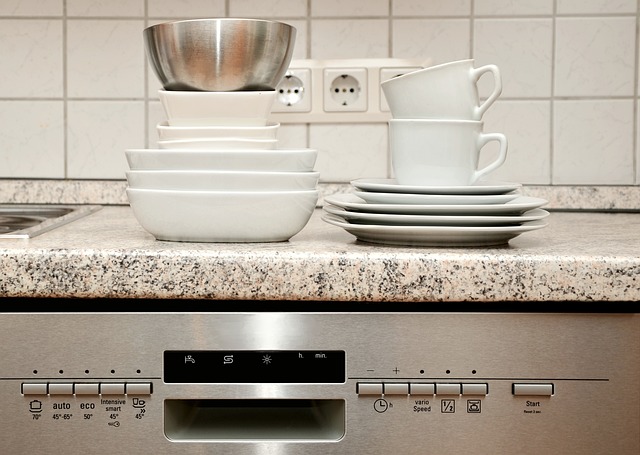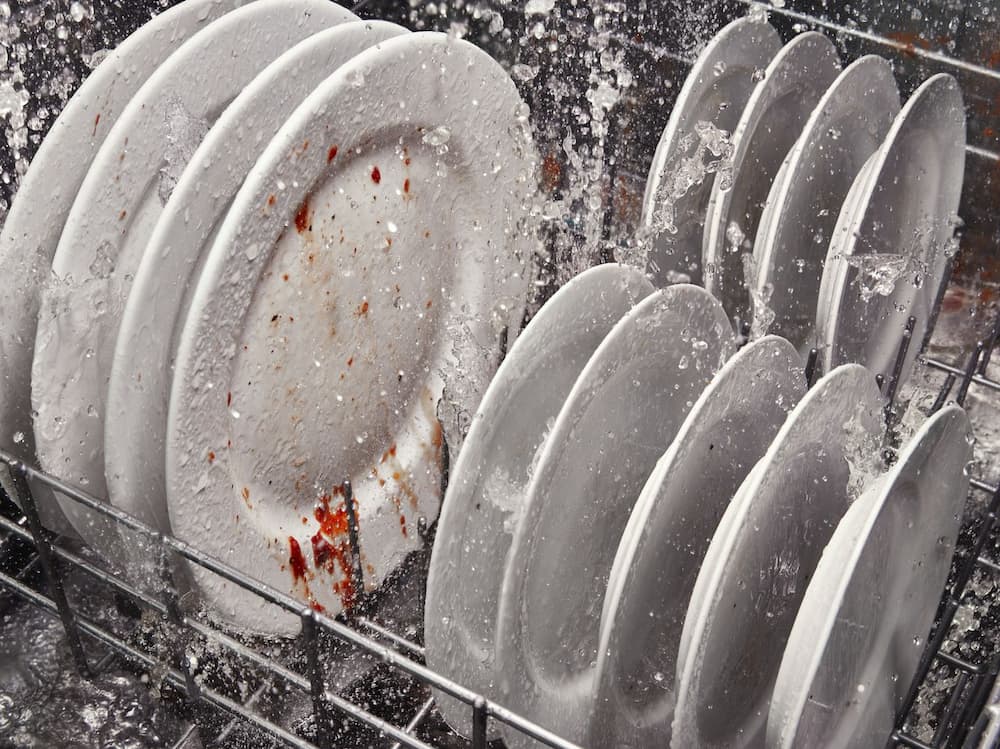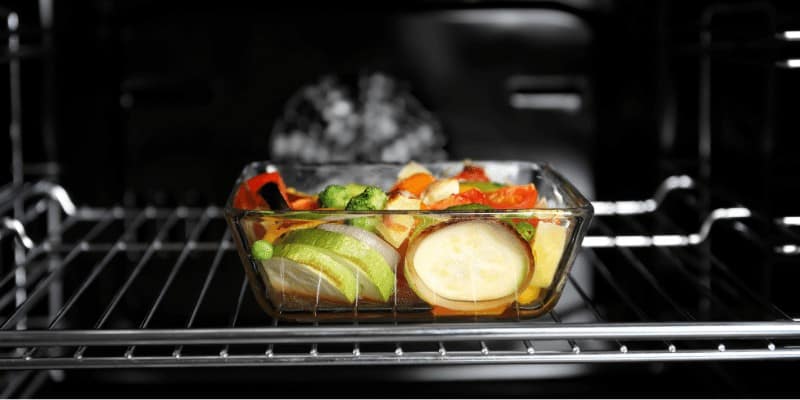A dishwasher is essentially a robot that washes and cleans soiled dishes. The dishwasher performs a vast array of tasks by itself; humans only need to load the dishes, add detergent, set the appropriate washing cycles, and turn it on.
So, how does a dishwasher work?
A dishwasher working process: The dishwasher’s rotating arm sprays hot water and detergent to remove dirt and debris. Drainage was done of the filthy water. To wash the dishes, add new water. Using the appliance’s waste heat, the washing water is drained and the dishes are dried.
For more information, continue reading.
Table of Contents
How Do Dishwashers Work?
Ever questioned how your dishwasher operates? It can all seem a little mysterious once you close that door and hear the water begin to run. We have dispelled the myths and offered a detailed explanation of what occurs inside this enigmatic appliance.
- The bottom basin of the appliance is first filled with water.
- The rotating spray arms inside the appliance spray the dishes with a pre-wash.
- The water is heated internally to the proper temperature for the program you have chosen.
- The timer allows the detergent to enter the appliance.
- As the rotating arms circle the dishwasher, hot water and detergent are sprayed to remove dirt and debris.
- The contaminated water is drained off.
- The dishes are rinsed with fresh water added.
- Draining the rinse water allows the dishes to be dried inside the appliance with residual heat.
The Three Dishwasher Cycles
It is time to discuss the various cycles of a dishwasher now that you are familiar with how they operate. Typically, there are three stages to a dishwasher cleaning cycle:
Pre-wash Or Rinse Cycle
The first cycle of dishwashing is used to pre-wash and rinse your dishes because it is the shortest cycle. This cleans your dishes of larger food particles and prepares them for the subsequent longer, hotter main wash cycle. Some dishwasher models have a pre-wash detergent dispenser to give the entire wash cycle a little extra oomph.
Main Wash Cycle
The main wash cycle, which can last anywhere from 20 minutes to an hour, can be modified to fit the quantity of dishes in your unit or their level of dirtiness. In the main wash cycle, water is heated, pumped through the appliance, sprayed, collected once more, and then filtered several times as the cycle is repeated to get dishes spotlessly clean. Dishwater will then drain, signaling the end of the primary wash cycle, as soon as the heating coils stop operating.
Final Wash Cycle And Rinse
It does draw in fresh, new water during the final wash cycle. The final rinse serves the same purpose as the main wash but typically doesn’t use detergent. Any detergent or chemicals left on your dishes should be thoroughly rinsed away. After the water has stopped flowing, some units have a drying cycle that sanitizes your dishes using the hot air left over from earlier cycles.
Dishwasher Basics
Here are the main parts of a dishwasher:
Control Mechanism
In the door, behind the control panel, is the control mechanism. A timer controls how long each phase of the cycle lasts and activates the right function at the right time (like the detergent dispenser, wash spray, and draining functions) in many units. A computerized control system might be present in more expensive units. Additionally, modern units have a door latch that needs to be closed in order for the unit to operate. Many have locks with child safety features.
Water Intake Valve
This is where the dishwasher is supplied with water from the house’s water supply. The valve, which is mounted inside the dishwasher, opens and closes to allow in the right amount of water during a cycle. Water pressure causes the valve to open, allowing water to enter the appliance.
Circulation Pump
The circulatory pump is propelled by an electric motor. Water is pushed into the spray arms by the pump during the washing cycle. The pump directs the water into the drain hose during the drain cycle. Under the basin, in the middle of the dishwasher, is where the pump assembly is mounted. There are two main types of pumps:
- These pumps can switch between pumping water to the drain and the spray arms by rotating the motor in the opposite direction. Vertical mounting is the norm for reversible pumps.
- Pumps with a direct drive have a single-direction motor. Thus, a solenoid valve allows the water flow to change from the spray arms to the drain pipe. Horizontal mounting is typical for direct-drive pumps.
Dishwashers can be installed either permanently or temporarily. The top of portable units can serve as a countertop, and the sides are finished. The device is placed next to the wall and is dormant when not in use. When it’s time to run a cycle, the appliance can be moved on casters over to the sink, where it is plugged into an adjacent outlet and connected to the faucet.
The dishwasher is bolted into place and slides under the countertop in a permanent installation. Direct connections to the hot water line and the drain line are made through hoses under the kitchen sink, and the unit is typically plugged in there as well. A 120-volt grounded line is required for both types of installation.

Dishwasher Buyer’s Guide
The basic operation of all contemporary dishwashers is the same. Dishwasher cleaning is effective on even the most affordable models. As a result, choosing one involves deciding which features you’ll use and which ones you won’t. The main characteristics that differentiate one model from another are strength, size, and convenience.
Size
There are many different sizes available for dishwashers. Countertop and in-sink dishwashers, which can clean up to six place settings, are the smallest. As they sit on top of your counter, countertop units don’t need to be installed. A full load of laundry can be washed in an in-sink dishwasher in about 20 minutes, and they typically fit into one half of a double kitchen sink. The unit’s cover transforms it into a countertop when not in use.
A dishwasher should be at least 24 inches (61 centimeters) wide. However, 18-inch (46-centimeter) units are available, sometimes known as “apartment-sized” dishwashers. Naturally, a dishwasher can hold more dishes the wider it is. A 30-inch (76-meter) model might be appropriate if your family is large. If it is any bigger, you are probably looking at a commercial dishwasher.
Dish Drawer, a compact dishwasher the size of a sizable kitchen drawer, is a more distinctive option. It is suitable for small kitchens that don’t have enough space for a full-sized dishwasher and uses less water and energy than a full-sized unit does. They also come in double-drawer designs, though, which can accommodate just as many dishes as a typical dishwasher. These drawers are perfect for kitchens where a dishwasher door would obstruct a walkway because they operate independently and use less water and energy.
Basins And Racks
Dishwasher models that are more affordable have plastic basins, while some mid-range and all expensive models have stainless steel basins. In less expensive models, food particles collect in a filter that needs to be manually cleaned on a regular basis. More expensive models come with self-cleaning filters, and some even have little grinders that chop up big chunks so they drain with the dirty water.
There are numerous variations of dish racks. With folding tines, additional shelves, collapsible racks, and removable racks for loading outside the machine, the dishwasher will be more flexible and adjustable the more you pay for it. Take any large or unusually shaped dishes you’ll be regularly washing to the appliance store to make sure the racks will fit them.
Extra Features
The latest technological advancements and energy-saving features are now standard on even the most affordable appliances of today. As an illustration, most dishwashers now have soil sensors that determine how dirty your dishes are and adjust the wash time and water amount accordingly to conserve water. Half-load and speed-wash cycles are two additional options for saving energy.
With WiFi connectivity, more expensive models, you can control your appliance from your smartphone. If there are young children present, you can lock the buttons, check the remaining cycle time, and start your dishwasher remotely. You can also get alerts when your rinse aid is running low or there might be a leak. In order to potentially save money, you can even set your dishwasher to only run during periods of low local energy consumption. A slim third rack for large, flat items, bottle jets to better clean baby bottles and water bottles, and racks you can move up and down are additional more recent features.
The fronts of expensive dishwashers can be stylish and mimic kitchen cabinets. If your kitchen is close to your living room, the additional cost of noise reduction might be worthwhile. The sound insulation in more expensive dishwashers is very thick. Keep in mind that dishwashers with grinders for large food chunks are noisier than those without.
Energy Use And Cost
The use of water and energy is a final point to consider. In order to assist you in choosing a dishwasher that is both economical and environmentally friendly, the US government’s Energy Star program compiles a list of the most effective models every year.
So what should you expect to pay for a modern dishwasher? A dependable, useful model would cost less than $600 in 2021. If you had $1,000 to spend, you could purchase features like a third rack, a quieter machine, and a potent food disposal. Dishwashers with every feature imaginable, including WiFi connectivity, extra cycles, hidden controls, LED lights, built-in water softeners, and water cleanliness sensors, cost up to $2,000 or more.
Unless your dishwasher is a pre-1990 model, it’s probably efficient because government regulations have greatly increased modern dishwasher efficiency. According to the Environmental Protection Agency, ENERGY STAR certified dishwashers use 12 percent less energy and 30 percent less water than standard models. Over the course of its lifetime, a standard-size ENERGY STAR certified dishwasher will save about 3,870 gallons (17,593 liters) of water while costing about $35 per year to operate.
Dishwasher use not only saves time, but also energy and water when compared to hand washing dishes. How much water is saved by an Energy Star dishwasher annually when compared to hand washing dishes? An amazing 7,000 gallons (26,500 liters). Additionally, it gives you 230 extra hours of time and saves you $111 on utility costs.
How A Dishwasher Differs From Hand Washing
When you wash your dishes by hand, the soap and water remain still in the bowl or sink, and you move the dishes as you scrub them with a brush or a cloth. In a dishwasher, the opposite occurs: the dishes and cutlery remain stationary in plastic baskets while pressurized jets of hot water shoot all around them. This means that a dishwasher must be kept completely closed at all times in order to prevent the water from shooting out in all directions and onto your kitchen floor!
A dishwasher’s cycle begins by absorbing cold water from a hose attached to the appliance. A heating element begins to warm the machine once a specific volume of water is present in the bottom of the device. The element, which is simply a thick metal bar that heats up when an electric current flows through it, gradually warms the water during the first phase of the wash cycle. The machine’s side has pipes that are connected to two rotating paddles by an electric pump, which uses the warm water to push it up. One metal paddle and one plastic paddle are located beneath the bottom and top dish racks, respectively.
The paddles spin when water enters them, resembling garden sprinklers in this way. Water spills out of tiny holes in the paddles’ upper surface as they spin. Your dirty plates are shot up into the air by numerous hot, spinning water jets created by the paddles. (Therefore, it is best to arrange your crockery so that the dirty surfaces face down.) Since the bottom rack and paddle are closer to the heating element, the water is much hotter there. (That’s why you’ll see some crockery items marked “Top rack dishwasher safe”—which means it’s alright to put them in the upper, cooler part of the machine.) Once the water has touched your dishes and plates, it returns to the machine’s bottom where it is heated by the element once more and pumped around for another cycle. Before all the dishes and plates are clean, water pumps around the machine for about 30 minutes. Large debris is caught in a sieve at the machine’s base to prevent jamming, while smaller debris and food scraps are simply flushed down the drain.
At the end of the cycle, what dries the dishes? It simply evaporates away in the heat because the water used to wash them is so hot. If you don’t overfill your dishwasher, the dishes should dry on their own and won’t need to be cleaned.
What Temperature Should The Water Be?
Dishwashers try to balance efficiency, effectiveness, and speed. You’ll use more electricity and pay more for each wash if the water is hotter and the cycle is longer. When it comes to hygiene, the hotter the water, the less time you’ll need to kill any pathogens (bacteria and other nasties) lingering on your pots and pans. According to the [PDF] World Health Organization (summarizing a number of different scientific studies), water at temperatures close to that used in pasteurization (~60°C or 140°F) kills pathogens rapidly, with “inactivation times” ranging from a few seconds up to 30 minutes (depending on the pathogen). In other words, you can be reasonably sure your dishwasher is cleaning your items in a hygienic manner if it is running at 60°C for 30 to 60 minutes. By the same token, it is evident that standard handwashing—a dip and swizzle in lukewarm water with bits of leftover food floating in it, using a brush or a sponge you may not have cleaned in days or weeks—is actually not at all hygienic.
Why Dishwashers Need Detergent?
Liquid or solid (tablet-form) detergent is the other component that every dishwasher needs in order to effectively remove grease and grime from your dishes.
You put the detergent in a dispenser in the door, and at some point during the wash cycle, usually after the machine first turns on, the dispenser flips open, dropping or dripping the detergent into the hot water bath at the bottom of the machine. Dishwasher detergents function very similarly to laundry detergents, about which you can learn more in our article on detergents. In a nutshell, they combine ingredients for removing the various types of food deposits that are likely to be left on your cutlery and crockery, as well as water softeners, anti-corrosion chemicals to prevent the machine from rusting, and enticing fragrances.
Apart from detergent, dishwashers also need occasional supplies of “salt” to reduce limescale and keep their built-in water filters working properly.
Kids and dishwashers don’t mix well. If you have a dishwasher, be sure to keep the detergent tablets well out of reach of younger children; according to a recent scientific study, in the In a single year, toxic laundry and dishwashing detergents were exposed to more than 62,000 children under the age of six in the United States alone. Another study by paediatricians in New Zealand confirms that dishwasher tabs can cause serious internal injuries: “Dishwasher detergents are very corrosive materials that can result in serious injuries and ongoing morbidity.” It suggests reducing the potency of the chemicals in detergents and utilizing more child-safe packaging.
Who Was The Dishwasher’s Inventor?
The first dishwashing devices consisted of a dish rack on a spindle with a water basin below. The dish rack was turned around by a hand crank, which caused water to be splashed. This was not very productive. Modern dishwashers were created in 1886 by Josephine Cochrane. Rich socialite Cochrane had expensive china that kept getting chipped while being hand-washed by her staff. At the 1893 Chicago World’s Fair, she introduced a rack and water jet system. She founded a business that later evolved into KitchenAid.
Dishwasher FAQs
The Value Of Purchasing A Dishwasher
Dishwashers are a good investment due to their efficiency in terms of cost and energy use. For big families and work environments, they are essential. A double drawer dishwasher might be preferable if your home doesn’t house as many people.
How Should I Pick A Dishwasher?
A good dishwasher should have a large unit capacity to handle a lot of dishes and large dishware. You should also look for specialty wash cycles such as “rinse and hold,” “quick wash,” “sanitize,” and “delicate.” The appliance’s energy usage is the last thing you should consider.
How Do Portable Dishwashers Drain?
A “unicouple,” which is a device that can be attached to a kitchen faucet, is used to drain portable dishwashers. The unicouple comes with two hoses, one for the sink and the other for the dishwasher.
Do Portable Dishwashers Function Just As Well As Built-in Ones?
Smaller households may benefit from portable dishwashers’ improved cleaning performance. However, there are clear restrictions and portable dishwashers have a lower unit capacity than built-in dishwashers. Families who rent their homes might find them to be a good fit.
Conclusion
You enter the shower when you’re feeling dirty. When your pots and pans get soiled, a dishwasher, a magical device, gives them a shower as well. Many people despise the tedious task of cleaning leftover food off of dirty dishes.
I appreciate you reading, a lot.



